If God was to recreate the reefs all over again, he would probably come up with something a lot like the reefs of Raja Ampat (“The Four Kings” in Malay).
In fact, Raja Ampat’s reefs are so healthy and prolific that it begs the question that whether all our reefs once looked like this long before the great declines set in (mainly due to the activities by men). Don’t take my word for it, after all, in comparison to “crusty old salts” I have not been diving long and far enough to lay such claims. Just consider these facts: over 1300 fish and 500 corals species inhabit the reefs surrounding Raja Ampat (1,500++ islands) archipelago, figures that greatly exceed those found in both Caribbean and the Red Sea combined. Since more than 75% of the marine species thrive in the “Coral Triangle” (a triangular area that encompasses the seas of Phillippines, Sabah, Bali and Papua New Guinea, generally recognised to be the richest seas on the planet) are widely found here, it is no wonder that scientists believe that Raja Ampat functions like an incubator/species factory:- Sperms, gametes, larvae and juvenile marine creatures are believed to have been spawned here and flowed with the ocean’s currents (Coriolis effect). in fact, according to Ah Tee, a scuba instructor & founder of Scuba Amigo, the tides in Dampier Straits near Mansuar Island have a disparity of 3 meters between high and low tides, a testament of how much water flows through the strait on a daily basis.
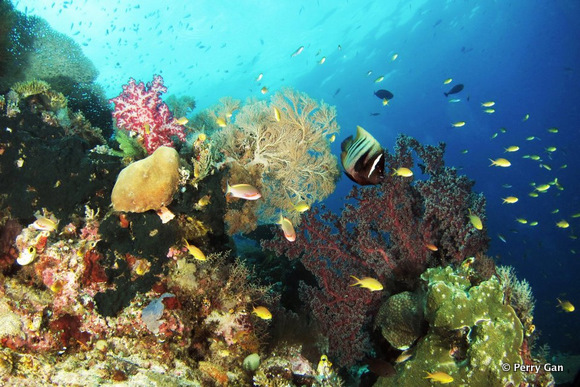
Reef.

Cave Coral with polyps extended.
Diving in Raja Ampat also means that we have to constantly remind ourselves not to take fish for granted just because there are so many of them. When we dive, we often pay more attention to stationary/sedentary objects like Nudibranchs (fondly called ‘nudies’, shrimps and other invertebrates we forget that all the swimming fish deserve attention and respect too. in Raja Ampat, some dive sites are just roiled with thousands of fishes, and it’s so easy to look away although we could be swimming with a school of fishes previously unknown to men (imagine 9 out of 10 world records for fish diversity were charted in Raja Ampat’s sites). So under Tee Kok Yao’s (Ah Tee) helm and guidance we embarked on a “look and count the number of fishes” and “appreciate the terrain and coral formations” mission to justify being a good and observant diver. And we were not disappointed! Some sites were so covered with life that the kind of experience was akin to swimming inside a well stocked aquarium. Having said that, Raja Ampat’s muck diving was great too (probably not as crazy as Lembeh but we were perpetually surprised by many little treasures that we found). Among the first sightings for me: The very famous Raja’s walking shark, Denise and Pontohi pygmy Seahorses, Wobbegong Sharks, Toadfish, Archerfish, Winged Pipefish, some unidentifiable gobies, strange cowries and many more…

Decorator Crab
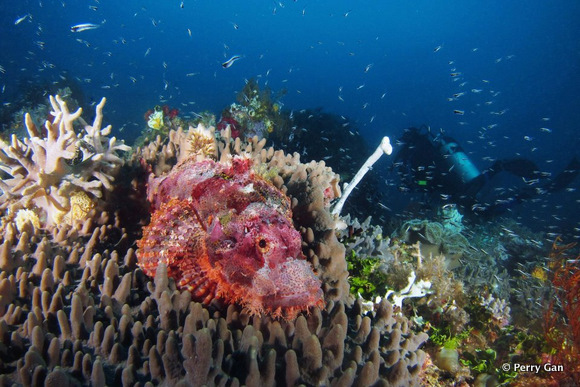
Scorpionfish lying in wait of prey….
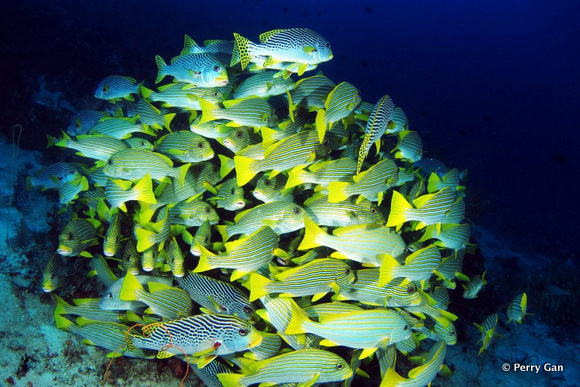
Schooling Sweetlips.
Currents were strong and swift (some up to 2 knots, so getting yourself a reef hook is a good idea) and visibility was remarkable (only 1 day of bad vis out of the 11 diving days). Being a fuddy duddy and pernickety diver armed with a super long wish-list, I have no qualms diving at Raja Ampat. Not even the lack of air and hence missed out on the opportunity talking pictures of 7 cavorting Mantas could dampen my spirits…(well at least I got to snorkel with them, and came to as close as 1 meter with 2 individuals). Well, I have to admit that not every dive was perfect, when the “elements” were not aligned, certain sites were a little less than stellar: Like all of us concurred that the dive at “Passage” was a little “underwhelming”, given its celebrated status we had expected some “spit out the reg” moments but this did not happen. “Citrus Ridge” was having a bad “hair” day as visibility went down and the soft coral polyps were retracted due to a lack of currents. Having said that, there were still lots to spot in both dives and when in a GOOD day that Raja Ampat and its dive sites stepped up in “full bloom”, we all went gaga and refused to surface until we absolutely had to.
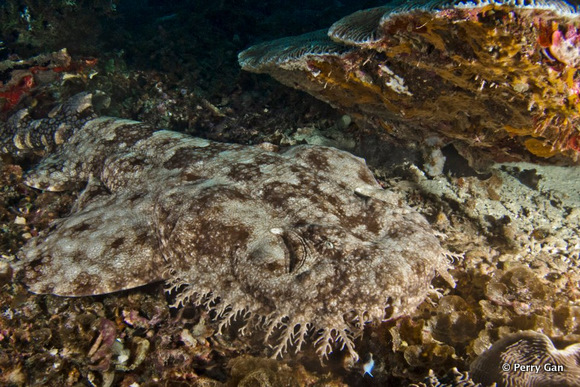
Wobbegong Shark
To all those who have plans to go to Raja Ampat, I would strongly suggest a Liveaboard (LOB boat) rather than land based resorts. Thats’s because Raja Ampat dive sites are so widespread and diverse (from Walls to Jetty to Mangroves to Sandy to Corals, 200++ sites and still counting, nearly all world class), some sites would take too long to get to unless you are on an LOB. We did an 11 days diving package and we have only covered the Central and Northern region, and even with that amount of time we had to skim past some famous dive sites because we had to rush to the next which was like 2-3 hours away. There are still the South and South East to explore, and with that it would take another 2 weeks. So this calls for an encored visit… No wonder they say everything in Raja Ampat is SUPERSIZED.

Christmas Tree Worm

Allied Cowrie

Crinoid Shrimp.
Simply put, Raja Ampat is a marine haven. It’s like diving in gin clear water with Corals as big as trees, many within centimetres from the waterline and to be able to dive in a huge school of fishes that swirl over to engulf divers momentarily blocking out the sun. It’s like being at the edge of the mangrove forests with roots system that stretches out to the sea, some even encrusted with sponges and corals. Then immersed with around 300 species of fish (in a single dive!) and to be a part of congregations of hundreds of large fish, all seemingly unfazed by us bubble blowers……The four heavenly kings cast its spell on those who visit them, I, for one, am truly smitten and awestruck. Never mind about its remoteness, the long flights and transits, never mind if it cost me an arm and a leg (and even perhaps a kidney), Raja Ampat holds the throne of a King of Asia’s premier dive destinations.
Hail the majesties!

Phyllodesmium Nudibranch
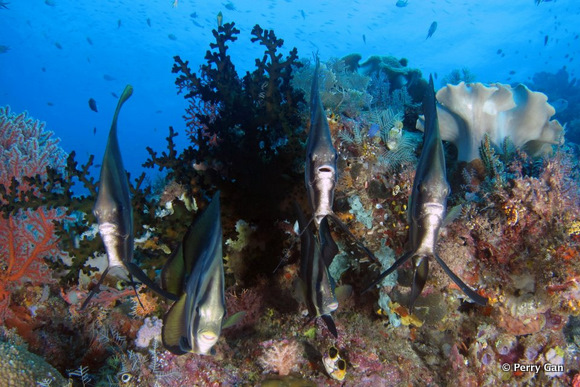
Batfish staring at me.
